米什金货币金融学PPT课件
- 格式:ppt
- 大小:1.60 MB
- 文档页数:65
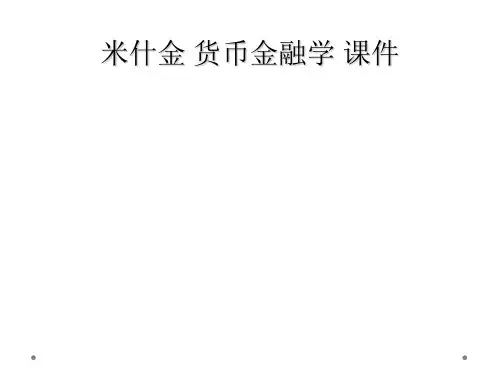
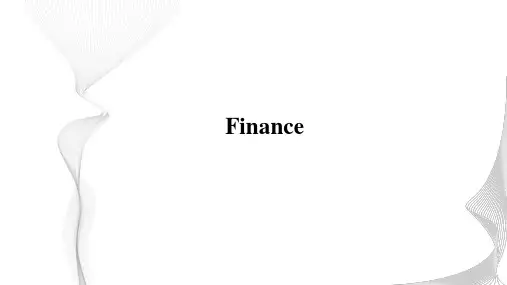
FinanceChapter1 IntroductionWhy Study Money, Banking, and Financial Markets An Overview of the Financial SystemWhat Is Money?Lecture 1Why Study Money, Banking, and Financial Markets?•Course Overview•Why Study Financial Markets?•Why Study Financial Institutions and Banking?•Why Study Money and Monetary Policy?Learning Objectives:How to construct a preliminary financial knowledge system Types of financial marketsTypes of financial institutionsHow the central bank implement monetary policyWhat is monetary theoryPart 1Why Study Financial Markets?1.1 Financial MarketsFinancial Markets (P2):Markets in which funds are transferred from people who have an excess of available funds to people who have a shortage.金融市场:资金从那些可用资金过剩的人转移到资金短缺的人的市场。
Why study financial markets?•Channel funds from savers to borrowers, thereby promoting economic efficiency•Affect personal wealth and behavior of business firms1.2 The Bond Market and Interest RatesBond (P3) is a debt security that promises to make periodic payments for a specified period of time.债券:是一种债务性证券,承诺在一个特定时间段内定期支付。
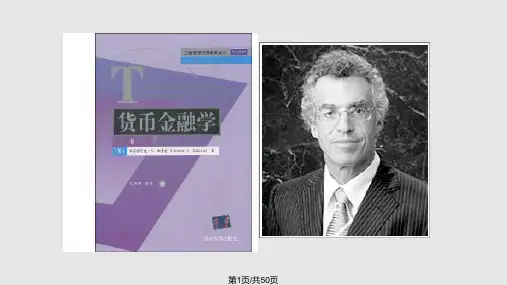


FinanceChapter2 Financial MarketsInterest Rates and Calculation of Interest RatesThe Behavior of Interest RatesThe Risk and Term Structure of Interest RatesThe Stock MarketTheory of Rational Expectations, and the Efficient Market HypothesisLecture 4Interest Rates and Calculation of Interest Rates •Interest Rate and Classification of Interest Rate •Simple and Compound Interest Rate •Present Value•Yield to Maturity and Its Calculation•The Distinction Between Interest Rates And ReturnsLearning ObjectivesCalculate the present value of future cash flows and the yield to maturity on the four types of credit market instruments.Recognize the distinctions among yield to maturity, current yield, rate of return, and rate of capital gain.Interpret the distinction between real and nominal interest rates.Part 1Interest Rate and Classification of Interest Rate1.1 Interest RateInterest rate (P3) is the cost of borrowing or the price paid for the rental of funds.利率是借款的成本或为借入资金支付的价格。

FinanceChapter4 Central Banking and the Conduct of Monetary PolicyCentral BanksThe Money Supply ProcessTools of Monetary PolicyLecture 10Tools of Monetary Policy•Goals of Monetary Policy and Conventional Monetary Policy Tools•The Market for Reserves and the Federal Funds Rate •How Tools of Monetary Policy Affect the Federal Funds Rate •Advantages and Disadvantages of Conventional Monetary Policy ToolsLearning ObjectivesSummarize how conventional monetary policy tools are implemented and the relative advantages and limitations of each toolIllustrate the market for reserves, and demonstrate how changes in monetary policy can affect the equilibrium federal funds rate.Part 1Goals of Monetary Policy and Conventional Monetary Policy Tools1.1 Goals of Monetary Policy•Price stability (*)•High Employment•Economic Growth•Stability of Financial Markets •Interest-Rate Stability•Stability in Foreign Exchange Markets1.2 Monetary Policy ToolsMonetary policy tools are the instruments used by the central bank to regulate the money supply and interest rates in order to achieve the goal of monetary policy.Conventional monetary policy tools :•Open market operations•Discount lending•Reserve requirementsNonconventional Monetary Policy Tools:Quantitative Easing, Credit Easing, Liquidity Provision, Large-Scale Asset Purchases, Forward Guidance and the Commitment to Future Policy ActionsPart 2The Market for Reserves and the Federal Funds Rate2.1 Goals of the Fed's Monetary PolicyThe goals of the Fed's monetary policy:According to the Federal Reserve Act, the goal of U.S. monetary policy is to control inflation and promote full employment.Intermediate goals of the Fed's monetary policy:The Fed uses the federal funds rate as the main monetary policy monitoring indicator and manipulation target.2.2 The Market for Reserves and the Federal Funds Rate•Demand CurveRR dd= Required reserves + Excess reservesThe trend of demand curve:As the federal funds rate ii ffff decreases, other things being equal, the opportunity cost of holding excess reserves decreases and the demand for excess reserves increases——the demand curve is downward sloping——but the process is not over.2.2 The Market for Reserves and the Federal Funds Rate•Demand CurveThe trend of demand curve:Since 2008, the Fed has paid interest on reserves at a level that is typically set at a fixed amount below the federal funds rate target.Suppose the interest rate paid on reserves is ii oooo, when federal funds rate ii ffff begins to fall below ii oooo, banks do not lend in the overnight market at a lower interest rate. Instead, they just keep on adding to their holdings of excess reserves indefinitely——the demand curve becomes flat (infinitely elastic)2.2 The Market for Reserves and the Federal Funds Rate2.2 The Market for Reserves and the Federal Funds Rate•Supply CurveRR ss= Nonborrowed reserves (NBR)+ borrowed reserves (BR) NBR: Amount of reserves that are supplied by the Fed’s open market operations. BR: Amount of reserves borrowed from the Fed, the interest rate charged by the Fed on these loans is the discount rate,ii dd, which is set at a fixed amount above the federal funds target rate.2.2 The Market for Reserves and the Federal Funds Rate•Supply CurveThe trend of supply curve:Borrowing federal funds from other banks is a substitute for borrowing (taking out discount loans) from the Fed.When ii ffff< ii dd,banks will not borrow from the Fed because borrowing in the federal funds market is cheaper, so BR=0, R s= NBR. And so the supply curve will be vertical. When ii ffff> ii dd, banks will want to keep borrowing more and more at ii dd and then lending out the proceeds in the federal funds market at the higher rate, ii ffff. The supply curve becomes flat (infinitely elastic) at ii dd.2.2 The Market for Reserves and the Federal Funds Rate2.2 The Market for Reserves and the Federal Funds Rate•Market EquilibriumMarket equilibrium occurs when the quantity of reserves demanded equals the quantity supplied, RR dd=RR ssEquilibrium therefore occurs at the intersection of the demand curve RR dd and the supply curve RR ss, with an equilibrium federal funds rate of ii ffff∗When ii ffff>ii ffff∗, more reserves are supplied than are demanded (excess supply). When ii ffff<ii ffff∗, more reserves are demanded than are supplied (excess demand).2.2 The Market for Reserves and the Federal Funds Rateii dd>ii ffff>ii ooooPart 3How Tools of Monetary Policy Affect the Federal Funds RateOpen market purchase leads to greater quantity of reserves supplied, which increases nonborrowed reserves.Open market sale leads to less quantity of reserves supplied, which decreases nonborrowed reservesThe effect of an open market operation depends on whether the supply curve initially intersects the demand curve in its downward-sloped section or in its flat section.If the intersection initially occurs on the downward-sloped section of the demand curve, an open market purchase causes the federal funds rate to fall, whereas an open market sale causes the federal funds rate to rise. (typical situation)If the supply curve initially intersects the demand curve on its flat section, open market operations have no effect on the federal funds rate, because the interest rate paid on reserves, ii oooo, sets a floor for the federal funds rateThe effect of a discount rate change depends on whether the demand curve intersects the supply curve in its vertical section or its flat section.If the intersection occurs on the vertical section of the supply curve, there is no discount lending and borrowed reserves (BR=0). When the discount rate (ii dd) is lowered by the Fed, no change occurs in the equilibrium federal fundsrate. (typical situation)If the demand curve intersects the supply curve on its flat section, there is some discount lending (BR>0). When the discount rate (ii dd) is lowered by the Fed, the equilibrium federal funds rate falls, and BR increases.When the required reserve ratio increases, required reserves increase and hence the quantity of reserves demanded increases for any given interest rate.When the Fed raises reserve requirements, the federal funds rate rises.When the Fed decreases reserve requirements, the federal funds rate fallsMonetary PolicyTools How to Affect Money Supply and ii ffffOpen Market Operations•Affect Money Supply: Open Market Purchase → MB↑→M↑•Affect ii ffff : a) Open Market Purchase → ii ffff ↓ (Usually)b) Open Market Purchase → ii ffff remains unchangedDiscount Lending •Affect Money Supply: a) Discount rate change → M is unchanged (Usually)b) Discount rate ↓ → M↑•Affect ii ffff : a) Discount rate change →ii ffff remains unchanged (Usually)b) Discount rate ↓ → ii ffff ↓Reserve Requirements•Affect Money Supply: rr ↑→M↓•Affect ii ffff : rr ↑→ii ffff ↑3.4 Summary3. How Monetary Policy Tools Affect ii ffffPart 4Advantages and Disadvantages of Conventional Monetary Policy ToolsMonetaryPolicy ToolsAdvantages DisadvantagesOpen Market Operations •The initiative lies with the centralbank•Flexible and precise•Can be executed quicklyMust be based on well-developed financialmarkets, i.e. there must be a sufficient variety andnumber of securitiesDiscount Lending •Central bank can act as the lenderof last resort•Central banks can realize theirpolicy intentions by increasing ordecreasing the discount rate•Central banks can only affect discount rate,but cannot command banks to borrow•When ii dd remains unchanged, changes in ii ffffmay change discount loans and money supply.•Central bank's changes in the discount ratemay be misinterpreted by the market.MonetaryPolicy ToolsAdvantages DisadvantagesReserve Requirements •The initiative lies with the central bank•Can have a rapid, powerful and widespreadimpact on the money supply•Acts on all banks or depository financialinstitutions, and is objective and fair to allfinancial institutions.•Can reflect the policy intention of the centralbank.•The effect on the money supplyis too violent and lack ofelasticity;•The expected effect of thepolicy is largely limited by theamount of excess reserves in thebanking system.SummaryT H A N K S。
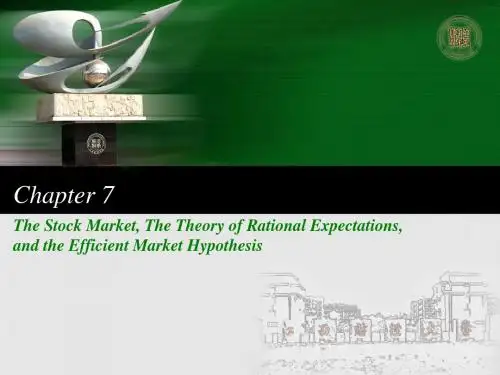
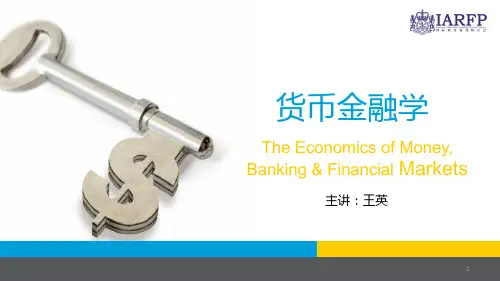
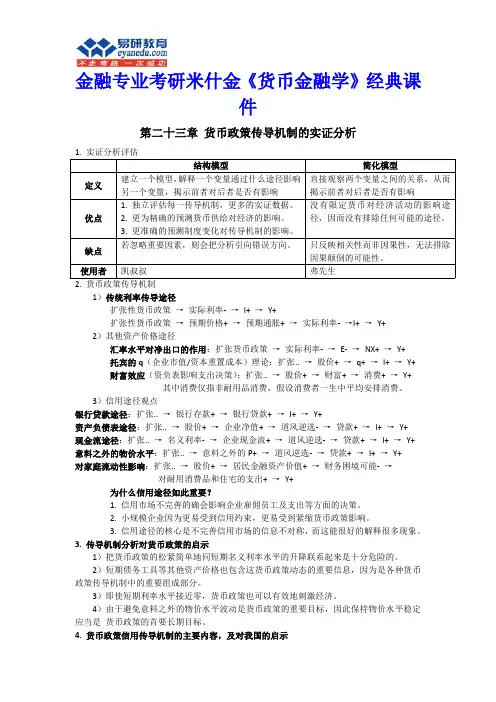
金融专业考研米什金《货币金融学》经典课件第二十三章货币政策传导机制的实证分析1.实证分析评估结构模型简化模型定义建立一个模型,解释一个变量通过什么途径影响另一个变量,揭示前者对后者是否有影响直接观察两个变量之间的关系,从而揭示前者对后者是否有影响优点1.独立评估每一传导机制,更多的实证数据。
2.更为精确的预测货币供给对经济的影响。
3.更准确的预测制度变化对传导机制的影响。
没有限定货币对经济活动的影响途径,因而没有排除任何可能的途径。
缺点若忽略重要因素,则会把分析引向错误方向。
只反映相关性而非因果性,无法排除因果颠倒的可能性。
使用者凯叔叔弗先生2.货币政策传导机制1)传统利率传导途径扩张性货币政策→实际利率-→I+→Y+扩张性货币政策→预期价格+→预期通胀+→实际利率-→I+→Y+ 2)其他资产价格途径汇率水平对净出口的作用:扩张货币政策→实际利率-→E-→NX+→Y+托宾的q(企业市值/资本重置成本)理论:扩张..→股价+→q+→I+→Y+财富效应(资负表影响支出决策):扩张..→股价+→财富+→消费+→Y+其中消费仅指非耐用品消费,假设消费者一生中平均安排消费。
3)信用途径观点银行贷款途径:扩张..→银行存款+→银行贷款+→I+→Y+资产负债表途径:扩张..→股价+→企业净值+→道风逆选-→贷款+→I+→Y+现金流途径:扩张..→名义利率-→企业现金流+→道风逆选-→贷款+→I+→Y+意料之外的物价水平:扩张..→意料之外的P+→道风逆选-→贷款+→I+→Y+对家庭流动性影响:扩张..→股价+→居民金融资产价值+→财务困境可能-→对耐用消费品和住宅的支出+→Y+为什么信用途径如此重要?1.信用市场不完善的确会影响企业雇佣员工及支出等方面的决策。
2.小规模企业因为更易受到信用约束,更易受到紧缩货币政策影响。
3.信用途径的核心是不完善信用市场的信息不对称,而这能很好的解释很多现象。
3.传导机制分析对货币政策的启示1)把货币政策的松紧简单地同短期名义利率水平的升降联系起来是十分危险的。
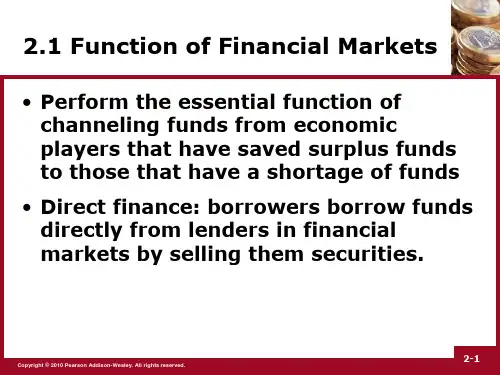
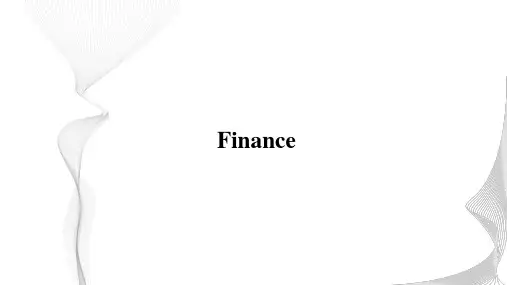
FinanceChapter2 Financial MarketsInterest Rates and Calculation of Interest RatesThe Behavior of Interest RatesThe Risk and Term Structure of Interest RatesThe Stock Market, theTheory of Rational Expectations, and the Efficient Market HypothesisLecture 6The Risk and Term Structure of Interest Rates•Risk Structure of Interest Rates•Term Structure of Interest RatesExpectations TheorySegmented Markets TheoryLiquidity Premium and Preferred Habitat TheoriesLearning ObjectivesIdentify and explain the three factors affecting the risk structure of interest rates.List and explain the three theories of why interest rates vary across different maturities.Part 1Risk Structure of Interest RatesOne attribute of a bond that influences its interestrate is its risk of default.Default occurs when the issuer of the bond is unable or unwilling to make interest payments as promised or pay off the face value when the bond matures.债券的违约(default)风险是指债券发行人无法或不愿履行其之前承诺的支付利息或债券到期时偿付面值的义务1.1 Default Risk1.1 Default Risk1.1 Default RiskU.S. Treasury bonds have usually been considered to have no default risk. Bonds like treasury bonds with no default risk are called default-free bonds.美国国债通常被认为不存在违约风险,像这种没有违约风险的债券被称为无违约风险债券(default-free bonds)。